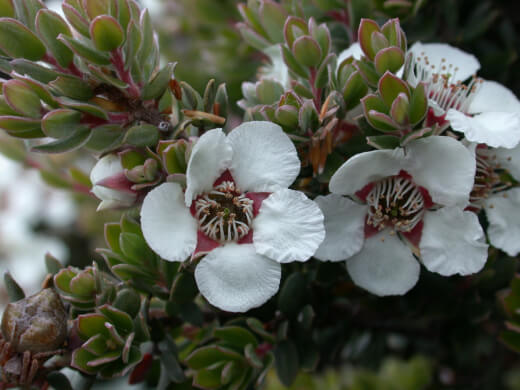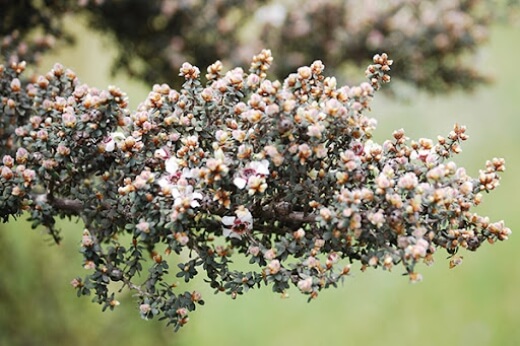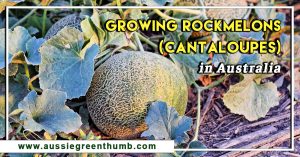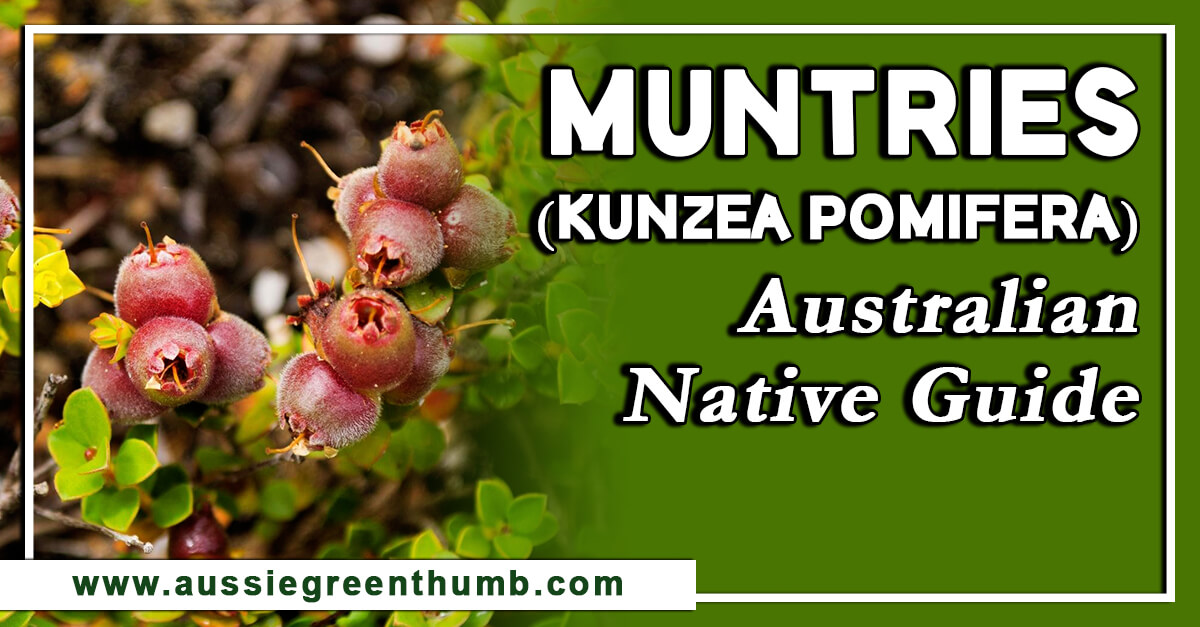Leptospermum lanigerum, or Woolly tea tree, is a curious Australian cultivar grown extensively across the East Coast. Endemic to areas around Victoria and Tasmania, this tea tree species offers stunning foliage and big, white blooms – making it a great addition to any Australian garden.
Considering growing Leptospermum lanigerum in your garden? Here is our complete growing guide to help you cultivate, care for and grow this Leptospermum species.
More...
Leptospermum lanigerum Features
Family: Myrtaceae
Genus: Leptospermum
Species: L. lanigerum
Common Name: Woolly Tea Tree or Silky Tea Tree
Flower Colour: White
Foliage Colour: Green
Growth Habit: Shrub to 3m
Flowering: Summer

Photo: Ivan Holliday, Westflora on Flikr
Where Does Woolly Tea Tree Come From?
Woolly tea tree, or silky tea tree, is a very common background shrub or screening plant. Endemic to the east coast, varieties of this cultivar can be found along tropical and subtropical regions of Victoria and Tasmania.
As this would suggest, it prefers a cool to cold climate, though success in temperate areas is possible. This variety is not recommended for subtropical or tropical areas, though they have been grown along the coast around Brisbane.
In its natural habitat, this species can grow anywhere between 1 metre to 18 metres tall. Part of the Myrtle family, this cultivar has large white blooms and deep green leaves, which often begin to look silver when fully mature.
Lanigerum plants were dubbed the nickname ‘Tea Tree’ by early European settlers who had used the leaves of certain lanigerum species as a tea substitute.
How to Grow Leptospermum lanigerum

Silky tea tree requires a few basic conditions for growth, which, when fulfilled, will lead to a happy growing, profusely flowering plant. Silky tea trees grow best in a full sun position but can also tolerate part shade. While it’s relatively hardy, it will need a little protection from major, cold winds.
This cultivar enjoys acid, neutral, sandy or loam soil. It is important to note that lanigerum can tolerate overly wet soils, so a moisture-rich soil mix won’t pose a problem. However, it is essential that the soil drains eventually.
Propagating Woolly Tea Tree
Lanigerum can be easily propagated from both seed and cuttings. Seeds are readily available from the small fruits, which are produced after flowering. These fruits remain closed until plucked.
Seeds can then be removed and sown during spring and autumn. It is important to note that seeds can be slow to germinate, so you will have to have a little bit of patience.
Be sure to keep seedlings in a warm and sunny spot. Cuttings are very quick to root and can be taken from healthy, thriving plants. Be sure to take a large enough cutting to ensure it has enough leaves to promote fast root growth. Keep cuttings in bright, filtered light.
How to Care for Silky Tea Tree

Source: Anpsa.org.au


Get Your Free Guide:
Master Growing Australian Natives eBook
A Must Have Complete Guide for Every Australian Garden
Get Your Free Guide:
Master Growing Australian Natives eBook
A Must Have Complete Guide for Every Australian Garden
There aren’t many resources regarding Leptospermum lanigerum woolly tea tree care. This is largely because these plants tend to care for themselves. The most important care instruction is to remember to water these plants freely.
As mentioned, they are happy to grow in moist soils, so with this cultivar, more is more. A slow-release fertiliser can be added annually but isn’t necessary for growth.
Pruning can be done to regulate the shape and size of this cultivar, especially if being used as a hedge or screening plant. Be sure to sterilize your shears before pruning to avoid spreading any diseases or fungi.
Lanigerum is known to be relatively pest and disease-free, so you won’t need to worry about any major issues on that front.
Leptospermum lanigerum Frequently Asked Questions
What is the common name for Leptospermum lanigerum?
The common name of L. lanigerum is Woolly Tea Tree. While Leptospermum is a separate genus to Myrtaceae, it is part of the wider plant family and shares many of the same chemical components that make up the flavour and aroma of tea tree leaves.
When does Leptospermum lanigerum flower?
L. lanigerum flowers in late winter and will continue flowering until late spring – typically for around 6 weeks. In cooler parts of the country, L. lanigerum may flower slightly later in spring, and a difference of a few metres can change their flowering times based on light levels (shaded trees will flower later in spring).
How many species of Leptospermum are there in Australia?
There are 83 recognised species of Leptospermum in Australia, and all are native, and spread widely across the country. Some species are limited to pockets of the south east, or Western Australia, but they are well suited to the majority of climates across the country.
Are Leptospermum lanigerum roots invasive?
L. lanigerum roots can be invasive if they are grown in very dry conditions. While they prefer good drainage, they will send vigorous roots out in search of water each summer and may damage property.
To alleviate the risk, plant tea trees at least twice as far from the house as their eventual height.
Is Leptospermum lanigerum frost hardy?
Most species of myrtle, and all plants in that family, including L. lanigerum are frost hardy right down to -10, making them one of the best all round trees for gardens with challenging conditions.
They grow well in inland gardens as well as coastal locations, and can put up with the frostiest winds.
Does Leptospermum lanigerum need full sun?
L. lanigerum prefers full sun, and grows best on well-drained but moist soil in a bright, sunny location. However, these trees can tolerate quite poor drainage for short times, and will establish faster with smaller roots in slightly damp but bright conditions.
Can you grow Leptospermum lanigerum in shade?
Despite preferring full sun, L. lanigerum can tolerate deep shade, and will grow taller and narrower in response to the changed conditions. For shady spots near the house, or in gardens that are overlooked by tall conifers, they can be a great way to add native fragrance to your garden.
Is Leptospermum lanigerum fast growing?
L. lanigerum is a fast growing plant and can reach its full height in under ten years. After 5 years, your leptospermum should be flowering regularly, and producing fluffy, spherical seed pods which are great for foraging birds.
How big does Leptospermum lanigerum get?
After ten years, your L. lanigerum tree will grow to about 5-6m tall. With pruning, that can be limited easily to 3, or even 2 metres tall and will shape into a gorgeous garden shrub without the challenging height.
When should Leptospermum lanigerum be cut back?
If you are growing L. lanigerum as a hedge or shrub, it should be cut back each spring to encourage shorter, bushier growth from each stem. If you are pruning dead, damaged or diseased timber from a tree forming Leptospermum, spring is still the best time to cut to encourage new growth.
Can I grow Leptospermum lanigerum in pots?
L. lanigerum grows surprisingly well in pots, and doesn’t mind being restricted. Any plant that will eventually reach 6m tall will need some extra care to keep it happy in those limiting conditions, but with proper root pruning, and regular feeding, L. lanigerum can be grown successfully in pots on balconies or patios.
Is Leptospermum lanigerum evergreen?
L. lanigerum is an evergreen shrub, which holds its fragrant foliage all year round. In spring, last year’s leaf will drop and be replaced by fresh new greenery, ensuring year round foliage on these wonderful ornamental native trees.

Get Growing Woolly Tea Tree today!
Interested in growing some other Leptospermum plants? Check out our main Leptospermum growing guide. Now is the perfect time to start growing Australian natives, so why not start with the wonderful woolly tea tree?
Put it in the right spot and this fantastic feature plant will produce plenty of blooms throughout the spring and complement your garden with its evergreen foliage year-round.
Published on January 19, 2023 by Nathan Schwartz
Last Updated on January 27, 2025




